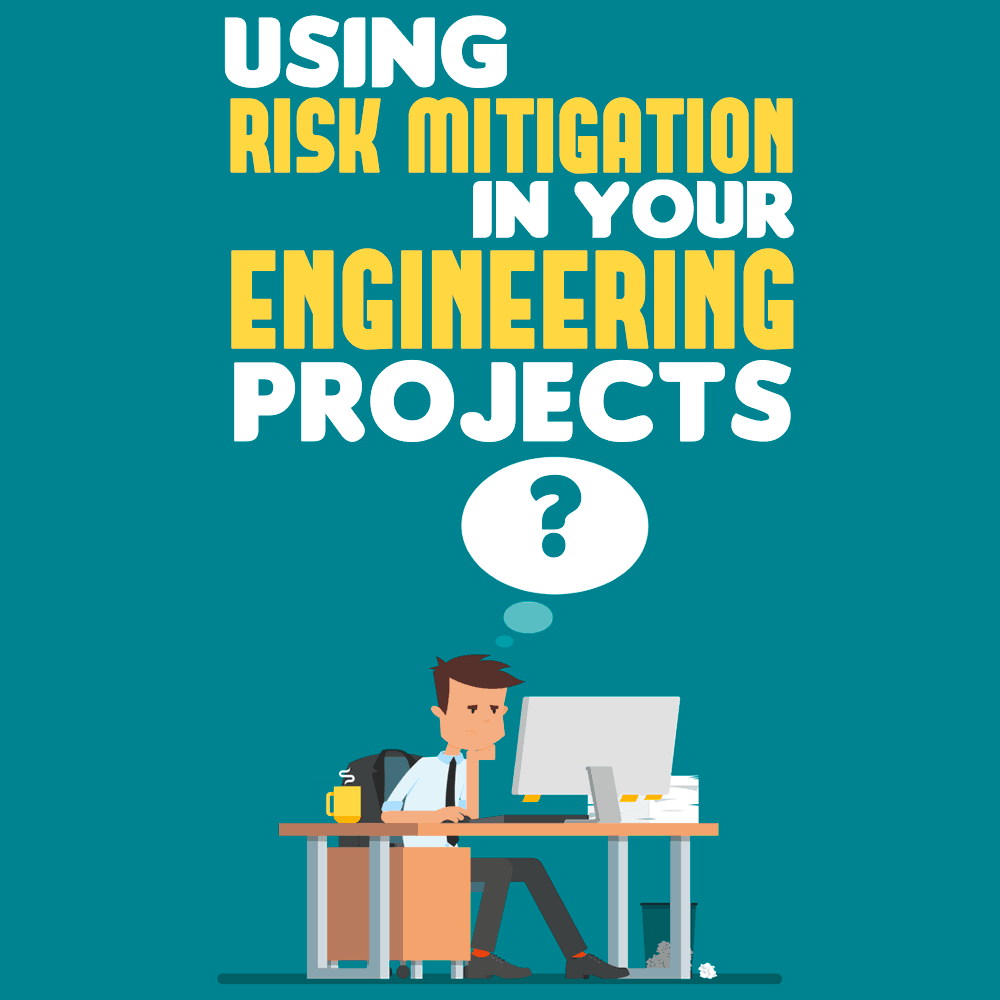
Ignoring common project risks can be a recipe for disaster. A risk that seems trivial at first can easily grow into a menace if left to fester. Ideally, it is essential to analyze the risk that every project poses and look for ways to mitigate it. In turn, project teams can feel at ease with better goal alignment, a streamlined decision-making process, a low-risk project, and a high engagement rate.
Risk mitigation is a plan for handling threats by eliminating or reducing their possible impact. It takes prudent measures to lessen the negative effect of risks and disasters during the system development life cycle (SDLC).
In software engineering, risks are behaviors or situations that compromise the success of software projects. They can negatively affect the budget, scope, and timeline of an assignment.
To avoid any project setbacks, you should watch for the common risks that occur in engineering projects and mitigate them as you go.
Types of Risk in Engineering Projects
Many threats can compromise the success of software development projects. Sample risks in software projects include the following:
- Management fails to prevent delays and setbacks, leading to unbudgeted expenditures.
- Management uses an inappropriate project management framework in managing a project.
- The project design doesn’t meet user requirements and the quality standards of the IT department.
- The SDLC documentation omits critical aspects like data security.
- An information system lacks controls to guarantee valid and accurate transaction processing.
Glitches can occur at any stage of the SDLC. Let’s look at some common reasons for faults seen in software development.
Ever-Changing Technology
Technology changes fast, and software developers have to adapt. Over time, the industry adopts new development platforms, tools, techniques, standards, and protocols. These changes make software development quite unpredictable.
Constant training is critical in engineering to reduce the risk that comes with new technology. Project failure sometimes results from the misguided adoption of unproven tools.
The same applies when choosing the application and system architecture to utilize. Coding in the wrong environment can mean an impending project failure. Broad consultation can help the team to select the most appropriate platform for the project.
Changes in Requirements
Engineering projects start with capturing all the user needs while keeping in mind the system features, functions, and services. Requirements gathering is usually tedious and lengthy.
For instance, some stakeholders may have personal agendas, and they will leave out anything that threatens to block their plans. Furthermore, user needs can evolve at the prototyping and integration stages of the product.
Adjustments may be necessary throughout the software development process. However, some changes in user requirements don’t automatically translate to functional requirements. The disparity can lead to project failure.
Insufficient Performance Testing
Most applications in business are accessible to users at different levels depending on whether they are management, employees, or vendors. An essential element to keep in mind is data security, more so when third parties are part of the end-user.
A software product with loopholes can make the organization vulnerable to cybercrime. Testing the product throughout the project is critical to ensure that all modules are functioning as intended.
Organizational Problems
Project management is at the heart of generating successful software products. Team leadership must plan for the development team’s needs, as well as the expectations of the client, for efficient project execution. The manager has to find the talent that matches various tasks of the project.
If the project manager has problems communicating, developers could misunderstand the scoping of the project. The team can eventually miss deadlines or build a product that doesn’t meet the expectations of the customer. There must be policies around stakeholder involvement and information sharing to avoid misperceptions.
How to Reduce Risks in Software Engineering

Project managers should identify and address risks before problems become inevitable. The most effective way to keep an engineering assignment running is monitoring threats and mitigating risks.
Proactive risk management saves you stress and increases the chances of project success. It involves recognizing, analyzing, and responding to risk factors in a project’s life. As part of the project planning process, it focuses on controlling the occurrence or impact of possible future events.
You can reduce risks in your software projects in six steps.
1. Risk Tracking
Before the onset of a software engineering project, identify all the probable risks, and stop them from becoming complicated. An ideal method to follow is to evaluate every feature you plan to develop, based on volatility, complexity, and your knowledge about it.
The point in risk management is tracking risk from the beginning to the end of a project. Apart from having risk tracking mechanisms, project managers should know where they are with projects at all times.
The level of volatility points to the likelihood of a feature changing, while completeness refers to how far you are in developing it. Relative complexity is the ease or difficulty of building a feature.
You can measure these parameters and assign them values as follows:
- Volatility – Low (L), Medium (M), or High (H)
- Completeness – Complete (L), Incomplete (M), or Unknown (H)
- Complexity – Simple (L), Standard (M), or Moderate (H)
By subjecting each feature in an ongoing project to these measures, you can estimate the average risk involved. The overall risk score will be either low, medium, or high.
2. Prioritization: Riskiest Areas First
With the risk scores for each feature, work on the riskiest steps first. By so doing, you will prevent some segments of the project from lagging too much.
At this stage, you will need to emphasize the possible technical and user experience challenges. You can notice them by visualizing high-risk steps in a risk assessment matrix and tracking them throughout project development.
The risk matrix increases risk visibility by multiplying the probability of an event occurring by its impact on the organization. Hence, a low risk is a situation that would have little effect if it happened, and vice versa for high-risk situations. The tool enables the development team to prioritize on the most threatening events, safeguarding the entire project.
As the project manager, you can ask the development team to research the solutions to potential risks using a timebox. Instead of staying in a stalemate with multiple problems, focusing on one at a time allows the team to resolve them much quicker.
Disasters usually happen when risks become overwhelming, and firms cannot decide what to give priority. To hasten the resolution process, let various individuals deal with the risk areas they understand best.
For design and user experience challenges, it’s vital to understand what your users want. Consider interviewing them and monitoring how they interact with the product.
This method of learning is extremely convenient when you are developing for a business in a sector you don’t understand. It provides insights that help the team to focus on what matters to the end-user.
3. Agile Approach to Development
This software engineering methodology allows the development and testing of software to go concurrently in iterations throughout the SDLC. It divides the project into smaller chunks to allow for quick identification of unforeseen risks and prompt action.
If you cannot predict every risk, allocate more resources to the most uncertain segments of the project. When you can anticipate the risks in a project, focus on the fundamental features with the lowest risk, and address the riskier parts areas later.
You can launch a minimum value project (MVP) to satisfy the client’s most pressing needs as you work on the unattended segments.
4. Risk Planning and Communication
To mitigate software development risks more conveniently, always have a plan to de-risk the project and communicate it to your clients. It may mean being transparent about everything you don’t know. By being open, the development team, as well as other stakeholders, understand the risks and mitigation methods.
Track the frequency of risks to occur and how often they raise problems using an issue and risk log. Highlight the top threats in the project status reports for your team to appreciate what it might encounter. Transparency often builds trust, and the client can have confidence that you will deal with eventualities.
5. Conversations and Feedback About the Development Process

Project managers need to be compassionate to the project team members. You become approachable when you show your team that you care. As a result, anyone with a problem that hinders their performance can raise the matter with you. By offering a solution, you can mitigate many risks associated with personnel.
A developer may have to be coding for iOS and Android projects at the same time. To maintain the expected quality of deliverables, they must be flexible programmers. If not, you may have to reorganize your team for everyone to maximize the available talent.
6. Assess the Team Temperature
As the project progresses, you should track how the development team feels about the assignment. The mood of the developers can illustrate their fears if any, and that could mean a risk to address.
You can take the team temperature by listening to the views of the project team and the clients about the project status.
For instance, is the team happy about its work and the entire project? If not, get to know what their fears are, and fix the problem. A two-minute survey can uncover impending risks beforehand, allowing you to mitigate them in time.
How you deal with risks can alter the scope, budget, and schedule of your project. Assessing the project features and interacting with various stakeholders in the development process assists the risk mitigation process.
Risk Mitigation Strategies in IT Projects
You can mitigate project risks using different tactics depending on the nature of the threat and the available budget. The most applied mitigation strategies in engineering are transference, avoidance, control, acceptance, and monitoring. Let’s elaborate.
Risk Transfer
In risk management, it’s not unusual for project owners to contract risk to parties best suited to handle them. However, it can be a complicated process, since you cannot transfer unquantified risks. In most cases, third parties agree to take risks for what they consider an adequate award.
You must quantify your risks to arrive at a reasonable and equitable price with your contractor. Risk transfer works best when you and the third party see value in entering into the contract. In software engineering, you may transfer project risks to another development company or an insurance firm.
Risk Avoidance
Another risk mitigation strategy in software projects is avoidance. It can take the form of elimination, where you change or get rid of the parameters causing the risk. By altering the blueprint, you can either make the risk disappear or reduce it to an acceptable level.
By making the risk disappear or reducing it to an acceptable level, risk avoidance is different than transfer and control because it seeks to avoid compromising events altogether.
The solution may be adjusting the budget, timelines, user and technical requirements, and so on. When taking this route, you must be careful not to introduce unknown risks that could impact the project more adversely.
It’s essential to involve the clients before changing the parameters of the project for them to understand the implications of not acting. You can present the product to the users after adjustments to see if your efforts are meaningful.
Risk Control
This methodology involves assuming a risk, but implementing measures to reduce or manage its impact or probability. If you can’t mitigate a threat or its severity when it strikes, you should implement risk controls.
One practical scenario is where controls reveal the root cause of undesired situations that the development team can address. Control measures may also detect and report unwanted events before they cause issues during the SDLC of the product.
You may install data-gathering and early-warning systems to harvest information regarding the assumed risk. The data can help you to predict the likelihood, timing, and impact of risk more accurately.
If you can get warnings early enough to respond in time, risk control may be more feasible than other mitigation strategies.
Acceptance (Assumption)
Risks can impact many aspects of your software development project, hurting its performance in different ways. By accepting a threat, you acknowledge its existence but decide to live with it without taking any control measures.
It's usually a last resort when you cannot eliminate, avoid, control, transfer, or reduce the risk. Sometimes, you have options like insurance, but it may not make business sense to cover some threats. Sometimes, the only option left for project continuity may be to assume the risk.
Risk assumption is reasonable when the danger associated with proceeding with a project is more tolerable than that of terminating it. The project manager should define the circumstances leading to risk acceptance and communicate it to all stakeholders.
Monitoring (Watching)

This strategy is about watching out for changes that can influence the risk. Even after you employ other methods of risk mitigation, there is a chance of the risk evolving due to external factors.
Project managers should be vigilant to ensure that the mitigation strategies remain effective throughout the SDLC. When a change interferes with the nature of a risk, it might be time to adjust the controls.
One area to observe is technological changes. The product you are developing today may soon become obsolete if you don’t adapt to modern design processes. You must stay abreast of the changes in the environment and tweak your project accordingly.
Risk Mitigation Is Achievable
The idea behind risk management is the same for most projects. In software engineering, it comprises risk identification, analysis, prioritization, and mitigation.
Strategies like avoidance, transfer, and control can prevent or reduce the brunt of different risks. Most importantly, remember to engage all project participants in risk analysis for effective mitigation.
